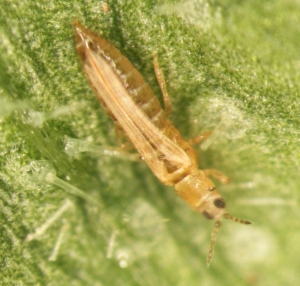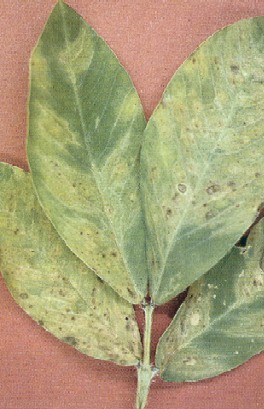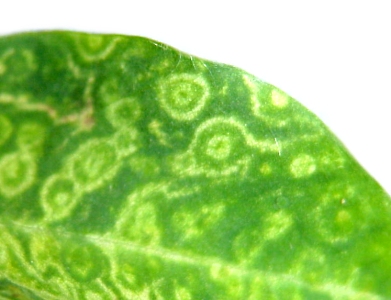Thrips
 Hosts
Hosts
Thrips have been collected from 29 plant orders, including various berries, cotton, day lilies, field crops, forage crops, grass flowers, legumes, peonies, privet hedges, roses, trees, truck crops, vines, and weeds. They seem to prefer grasses and yellow or light-colored blossoms. Roses are most susceptible in June.
Symptoms

Disease vectored
Tomato spotted wilt virus, a tospovirus, is found throughout the world and has a very wide host range infecting plants in over 50 families. In peanuts, TSWV is transmitted by thrips. The virus, acquired only by larvae, may be transmitted by larval and adult thrips. Yield losses attributed to TSW have been reported to exceed 50% in fields with high disease incidence.
Symptoms of TSW are variable. Plants infected early in the season may be stunted, mottled and distorted (third image). A common symptom is the presence of light green to yellow rings on leaflets (fourth image).
Life Cycle
 Thrips reproduce throughout the year with the majority of their 12 to 15 generations
occurring during the warmer months. Newly emerged females begin to lay eggs within
1 to 4 days in summer and within 10 to 35 days in winter, reproduction being much
faster in warmer weather. In summer the adult stage is reached in about 11 days. Flower
thrips pass through egg, two larval, prepupal, pupal, and adult stages. The eggs are
inserted into flower or leaf tissue, and the prepupal and pupal stages are spent in
the soil. In summer flower thrips may live 26 days, though overwintering thrips may
live all winter.
Thrips reproduce throughout the year with the majority of their 12 to 15 generations
occurring during the warmer months. Newly emerged females begin to lay eggs within
1 to 4 days in summer and within 10 to 35 days in winter, reproduction being much
faster in warmer weather. In summer the adult stage is reached in about 11 days. Flower
thrips pass through egg, two larval, prepupal, pupal, and adult stages. The eggs are
inserted into flower or leaf tissue, and the prepupal and pupal stages are spent in
the soil. In summer flower thrips may live 26 days, though overwintering thrips may
live all winter.
Description
Thrips are very small (1.25-mm or less), fringe winged, and yellowish brown to amber with an orange thorax. The male is slightly smaller and lighter in color than the female.
Control
Please contact your local county extension office for current information.
